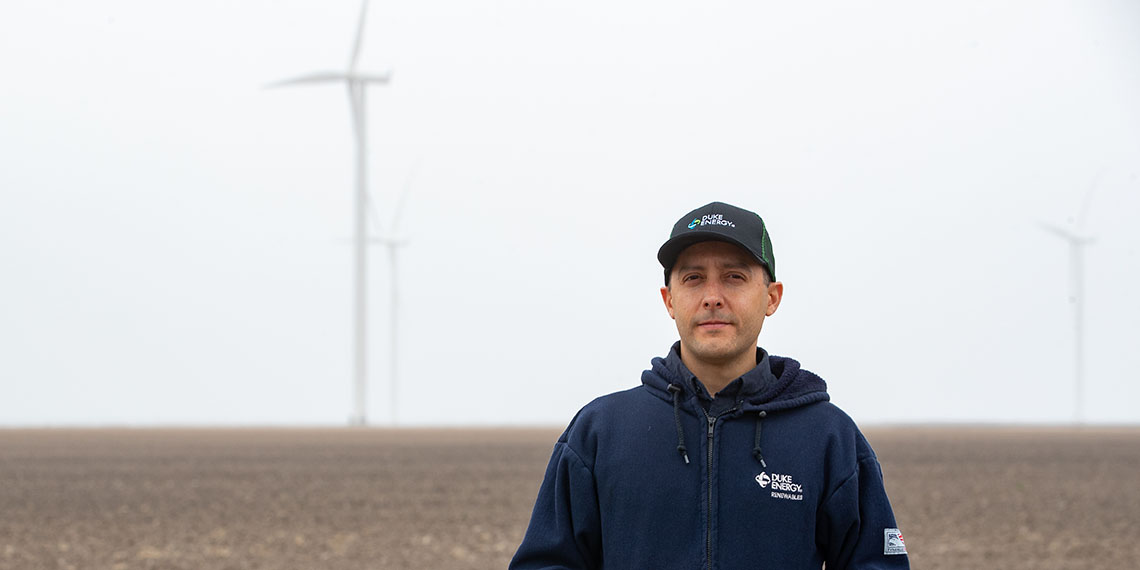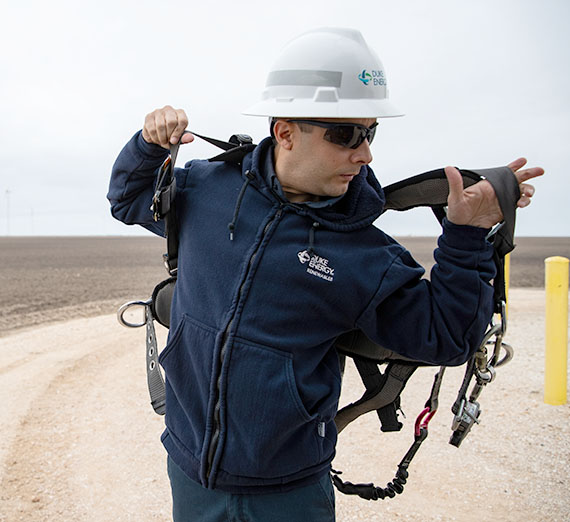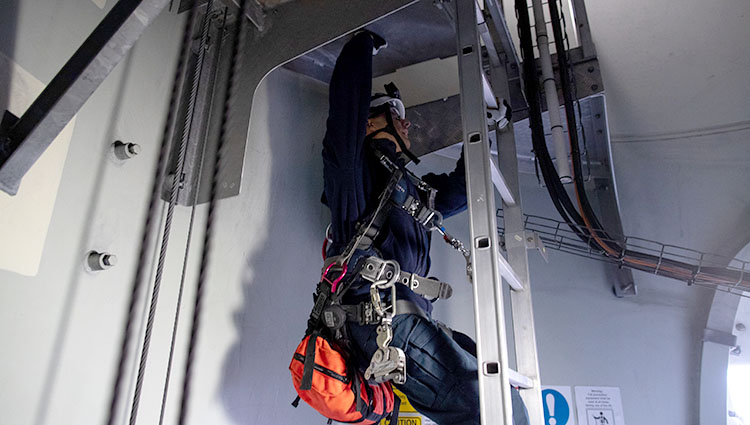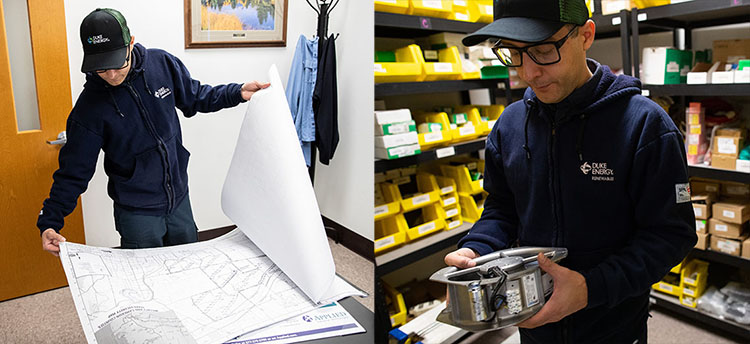Tomas Mendez: An Engineer in the Air


The hundreds of wind turbines at Los Vientos Wind Farm near Brownsville, Texas, tower over farm land at 300 feet tall – the height of the Statue of Liberty – and Mendez would soon have a greater appreciation for the height after climbing to the top.
Mendez earned a certificate in Power Transmission & Distribution from Gonzaga University's post-graduate engineering program. He’s an electrical engineer for Duke Energy Renewables, and his job is to make sure the parts that make up wind and solar farms are working together. Sometimes, that means climbing to measure for new parts or troubleshoot problems so wind technicians can order the right equipment and make repairs.
The first time he climbed, it was to figure out a way to prevent the oil cooling motors from failing. The solution was to install a soft-motor starter that would ease the rush of electrical current as the motor started, but he needed to make sure the new part would fit.

“They give you certification where you practice how to wear the equipment,” Mendez said, “but what they don’t teach you is the fact that you’re going to be working 300 feet in the air.”
He was sweaty, and he could feel the turbine sway like a boat rocking from side to side, which he didn’t expect. It took him almost an hour to get to the top. Today, he doesn’t take breaks and can climb to the top in less than 20 minutes.
The climb was worth it, though, to feel the breeze blowing and see the Gulf of Mexico in the distance and the tiny cars below.
“It was,” he said, “a rush.”

Mendez is based in Cincinnati, but his team provides engineering support for all of Duke Energy Renewables’ solar and wind sites across the United States. In January alone, Mendez worked at renewable sites in Texas, Wyoming and North Carolina. The job requires a lot of travel – so much that his middle child, who’s 4, thought Mendez worked at the airport.
“He’s always impressed by the equipment and turbines and everything,” Mendez said, “but I have told him many times, I don’t work at the airport. I work at many sites.” Before he took his current position in 2017, Mendez did wind construction engineering and helped build several wind farms including Los Vientos 3, 4 and 5 in Texas and Frontier in Oklahoma.
Between 2015 and 2017, Mendez helped construct 316 wind turbines to generate 710 megawatts of renewable energy. That’s enough to power about 140,000 homes at peak output. By 2020, Duke Energy plans to have 8,000 megawatts of renewable energy (the company currently has more than 6,400) as part of its commitment to diverse energy sources and reducing carbon emissions. That commitment to growth is what attracted Mendez to the renewables engineering team in 2015.
When he saw the job opening, he had already been with Duke Energy for seven years working on projects like keeping downtown Cincinnati’s underground grid running and engineering for the city’s smart grid initiatives.
“Renewables are new technology,” Mendez said, “and it’s the future of what we’re going to be doing.”

Mendez, who grew up in Puerto Rico, graduated from Marquette University in 2002 and, in a challenging job market, struggled to find an opportunity to use his electrical engineering degree. He found an engineering job for a construction company, but when the company went under during the 2008 housing crisis, he knew he had to find a way to use his electrical engineering skills.
In between his work, the travel that comes with it and raising three children, Mendez finds time to help students in Cincinnati find career opportunities they will enjoy, too. Through the Society of Hispanic Professional Engineers, Mendez helps organize events that teach students about STEM careers and helps parents who don’t speak English understand what their kids need for college and what kind of financial assistance is available.
One of the events, Noche de Ciencias, a science night for middle schoolers, inspired one student to pursue electrical engineering. Now in college, that student will intern with Mendez’s team in the summer.
“You’re doing it for the love of it,” he said, “and then you realize that you are making an impact.”
If Mendez could tell them one thing about engineering, he’d say it’s a lot of fun.
“There are challenging things and moments that are a little dull – when you have to sit down in front of a computer all day,” he said. “Fortunately, that’s not our day-to-day. That’s our every once in a while, and then we get to go outside. I never thought I would be up in the air in a turbine trying to figure out things and make them work better.”
Story originally published in Duke Energy Illumination
Q&A with Tomas Mendez
How has the T&D program helped in your career?
The Gonzaga University T&D program has helped me expand my technological expertise by providing courses that I apply to real life electrical engineering situations, whether it is related to substation, transmission, or generation. Being in the renewables industry, the Gonzaga T&D program has taught me about new technologies such as distributed generation and system automation, as well as more traditional knowledge, such as Power System Analysis and System Protection.
What was your favorite or most valuable learning experience in the T&D program?
The TADP 556 Engineering Leadership course. It teaches us to assume leadership roles inside and outside the engineering world, and teaches us to look at other areas where engineers generally do not contribute. Some examples include creating strategies for a company, and using effective communication as a leader.
Another valuable learning experience is the discussion boards. In the boards, you share best practices with others that are in the utility industry, and with others who are not in the industry (some are not even electrical engineers!). This network is conductive to keeping an inclusive and diverse point of view, one that is not exclusive to how your company sees the industry.
Is there something you learned in T&D courses that you use regularly?
The Power Systems Analysis is a course which I use on a regular basis. And often, I utilize concepts learned in other courses inside T&D and apply them to our regular career. For example, we learned about underground transmission design in one of the courses. The teachings of the course helped further understand the design of feeder systems for our wind farms.
- School of Engineering & Applied Sciences
- Master of Engineering in Transmission and Distribution Engineering
